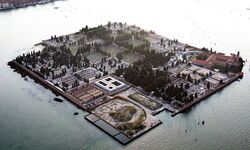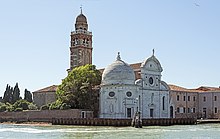Chremisa: Difference between revisions
No edit summary |
No edit summary |
||
| (One intermediate revision by the same user not shown) | |||
| Line 4: | Line 4: | ||
| native name link = | | native name link = | ||
| sobriquet = | | sobriquet = | ||
| | | image_name= File: Chremisa.jpg | ||
| | | image_size= 250px | ||
| image caption = | | image caption = | ||
| image alt = | | image alt = | ||
Latest revision as of 04:14, 22 November 2023
 | |
| Geography | |
|---|---|
| Location | Paradise Harbor |
| Administration | |
Blackhelm Confederacy | |
| Demographics | |
| Population | 12 |
Chremisa is an island in the Paradise City Harbor. It is most well-known for its sprawling cemetery, which takes up most of the island.
History
In the earlier days of Paradisian history, the island was a popular place for local travellers and fishermen to land for brief excursions and picnics. Mauricius Codus's Church of St. Michael on Chremisa was built on the island in 1456, as was a monastery. For a brief time in the 1500's, the island also served Paradise City as a prison.
Chremisa was selected to become a cemetery in 1803, designed by Julius Antonius Selvo, when it was decreed that burial on the mainland was unsanitary. Bodies were carried to the island on special funeral barges, and numerous notable and influential members of Exponential and Confederate society are buried here. The cemetery is still in use today.
Today
On top of the many graves of Imperial and Confederate citizens, the island is also the final resting place for numerous others from nations around the world. Perhaps the two most notable are the Andamonian empress Lahamisa II and her son Cueytatzl Ren I. Their remains were later transferred to the the imperial mausoleum in Zadé Axochizin, but markers in their memory can still be found on Chremisa


